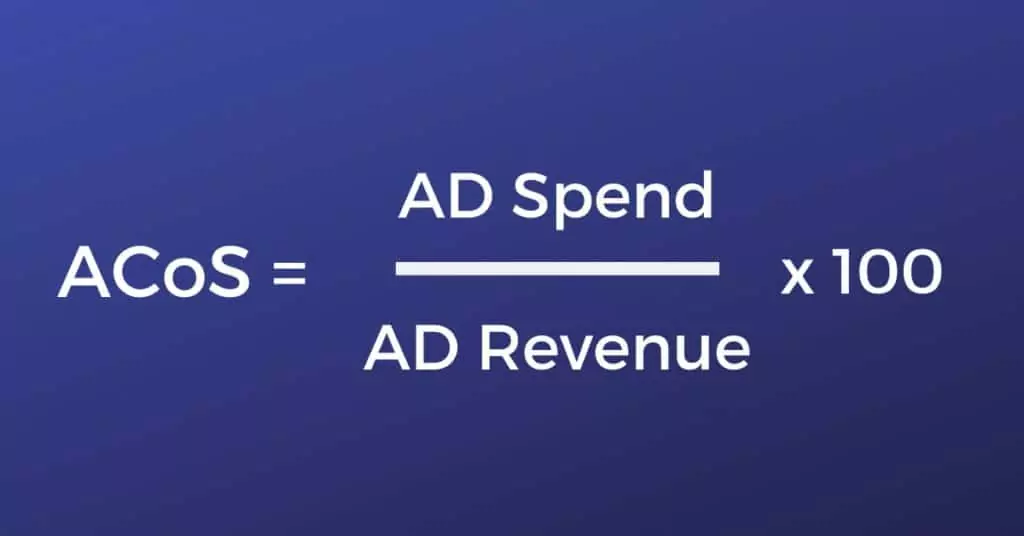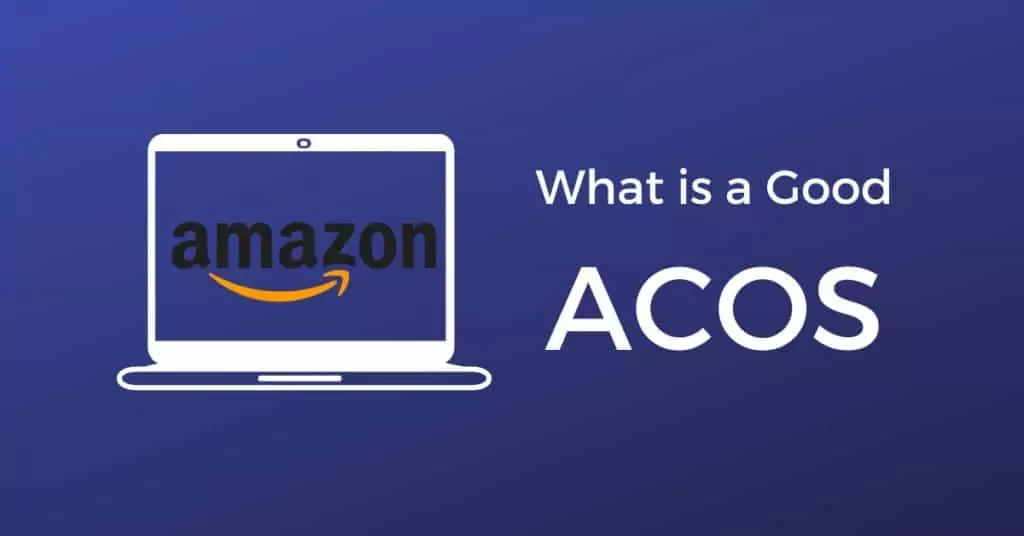What does ACoS mean on Amazon?
Before describing ACoS and answering “what is a good AcoS on Amazon”, it’s pertinent to describe how sellers use advertising on Amazon.
When browsing on the Amazon website, you may have noticed featured advertisements and product ads. These advertisements are advertised by sellers using the PPC advertising available on Amazon. In simple words, anyone selling a product on Amazon can use the advertising platform of Amazon to expose their products to thousands of Amazon visitors using advertisements based on the pay-per-click model.
What is the Advertising Cost of Sale?
Keeping in mind the advertising model on Amazon, ACoS measures the profitability of your ad campaign.
The lower your ACoS percentage, the more profitable your advertisement because a lower percentage shows that the advertisement campaign dollars are spent more effectively on the campaign.
As such, ACoS is the ratio of expense on a sponsored advertisement ad on Amazon to the total revenue generated from those sponsored ads.
It is pertinent to suggest that the benchmark value of a good ACoS may differ from industry to industry. Accordingly, the industry benchmark of your product may be different from the industry benchmark of another product sold by someone else. The difference in what constitutes a good ACoS differs due to a variety of factors that may include the type of product sold and its profit margin.
To make it easier for you to understand what is a good ACoS for you, we will also discuss a benchmark value of ACos that you may use to understand the profitability of your Amazon ad campaigns and the average ACos across different industry segments.
How to calculate ACoS?
ACoS for any Amazon PPC ad campaign is expressed in percentage terms. The formula for ACoS is:
Ad Spend / Ad Revenue * 100

A two closer look at the equation reveals that there are only two components in the formula, which makes it easier for everyone to calculate ACoS. Ad Spend is the total amount of cash that you may spend on the Amazon PPC Ad, while Ad Revenue is the total amount of revenue that you made by advertising on the Amazon PPC Ad platform.
Let’s assume that you sell baseball bats on Amazon. In the last month, you spent $200 on the Amazon PPC ad campaign to market your product, which led to total revenue of $800 just from the PPC ad campaign.
In this instance, your Advertising Cost of Sale, ACoS is:
$200 / $800 * 100
= 25%
As suggested earlier, the lower the ACoS, Advertising Cost of Sale, the better it is. A lower percentage cost is better because it reflects that the seller is using the advertisement dollars effectively.
Take a look at the above example again and assume that the total revenue generated from the PPC ad campaign is $400 instead of the $800 described above. In this instance, your Advertising Cost of Sale, ACoS is:
$200 / $400 * 100
= 50%
Comparing both scenarios, we can clearly see that the first instance was more profitable because it yielded a lower ACoS value.
Remember, a lower ACoS percentage suggests that your ad cost is lower in relation to the ad revenue.
Profit Margin
Earlier in the article, we indicated that the average ACoS across different industry sectors varies. Perhaps, the simple explanation for such variations is explained by profit margins.
Your profit margin is your “take-home” profit, which is the cash left after deducting expenses from the revenue. These expenses can be the cost of producing the product, storage costs, delivery cost, and Amazon Fee.
Reverting to the above example of baseball bats, let’s assume that your profit margin is very low because its expansive to produce the baseball bat. Even after getting 25% ACoS value, your “take-home” profit is just allowing you to stay afloat. To deal with the situation, you may increase the price of the baseball bat to increase revenue.
Let’s suppose that the revenue increases to $1000. Under the circumstance, your ACoS will decrease to 20% because:
ACoS = $200 / $1000 * 100 = 20%
If everything is constant, increasing revenue by taking more profits certainly decreases the ACoS, but you will also need to be aware of the sales impact on your baseball bats due to the increased price. In a perfect market condition, your ACoS may come back to 25% if there are fewer bats sold due to an increase in price.
This example shows why most Amazon sellers think that profit margin plays the most critical role in maintaining a good ACoS.
In fact, a good ACoS is a result of maintaining a fine balance between ad spend, revenues, and profit margins.
How do I improve and lower my ACoS on Amazon?
Understanding what’s your break-even ACoS will help you improve or lower your ACoS on Amazon.
A break-even ACoS is the point where your advertising cost is equal to your profit margin. In other words, break-even ACoS can easily tell you if you’re profitably using Amazon PPC ads or you will need to reevaluate your strategy.
Let’s go back to the example of the baseball bat to calculate break-even ACoS. Let us also assume that you spent $200 on Amazon PPC advertisements for selling baseball bats and the total revenue from the sales of baseball bats is $800. However, the profit margin is only 50% of $800, which is $400. This $400 profit margin is also the pre-ad profit.
Under these circumstances, your break-even ACoS is:
Pre-ad Profit (Profit Margin) / Revenue
$400 / $800 * 100 = 50%
In technical terms, 50% ACoS is the break-even point where you will earn a profit neither a loss.
To improve your ACoS on Amazon, you will need to lower the percentage. It also means that an ACoS value of 50% or lower will generate profits for you on Amazon and a value greater than 50% will generate a loss. This example shows that instead of looking at the revenue only, you should also pay attention to the profit margins.
Let’s see how profit margin can impact your relationship with Amazon ACoS:
Business ABC:
Ad Spending: $200
Revenue: $800
Profit Margin: 50% 0f $800 = $400
ACoS = $200/$800 * 100 = 25%
Break-Even ACoS = $400/$800 * 100 = 50%
Business XYZ
Ad Spending: $200
Revenue: $800
Profit Margin: 25% 0f $800 = $200
ACoS = $200/$800 * 100 = 25%
Break-Even ACoS = $200/$800 * 100 = 25%
The above hypothetical comparison between two businesses ABC and XYZ demonstrates that the ACoS value of both businesses is equal, but the Break-Even ACoS for both businesses different significantly. It differs due to the different profit margins of both businesses.
In this case, the profit margin of Business XYZ is much lower, which means that the business will require to lower its Break-Even ACoS by 25% or greater to remain in profit using Amazon PPC Ads. In contrast, Business ABC will likely have a much easier time to break-even due to higher profit margins. Accordingly, Business ABC will be profitable using Amazon PPC ads if the Break-Even ACoS value is less than 50%.
What is a Good ACoS (Advertising Cost of Sale) on Amazon PPC?
Before answering what’s a good ACoS, it’s important to highlight that no one among us would want to spend all of their profits on Amazon PPC ads. If you noticed, the break-even ACoS is calculated using the assumption that you will spend all your profits on the Amazon PPC ads; however, it is not logical to do so in the real-world.
To meet real-world challenges, you can set a target ACoS. A target ACoS is the number of profit margins that you will spend on the Amazon PPC ads.
Substituting the original value to the above example where the profit margin of the baseball bat seller was $400, the seller can set the target ACoS by allocating $200 out of $400 into the marketing funnel. If so, then the new ACos of the seller will be 25%, similar to the Business XYZ (see above comparison).
Irrespective of what target ACoS you set, here is an average ACos for different industry sectors. You can use these stats to compare where you stand in terms of the effectiveness of your Amazon PPC ads:
- Sporting & Recreational Equipment: 8.04%
- Consumer Electronics & Computers: 11.15%
- Jewelry & Watches: 11.54%
- Home Improvement & Hardware: 12.71%
- Apparel & Accessories: 12.89%
- Distribution & Wholesale: 13.29%
- Flowers, Gifts & Specialty: 13.35%
- Household Appliances: 14.20%
- Office Products: 16.08%
- Beauty & Health: 19.01%
- Furniture & Decorations: 20.17%
- Toys & Games: 21.65%
- Pharmaceuticals: 23.10%
- Records, Videos & Books: 25.31%
- Vitamins & Supplements: 30.05%
- Consumer Goods – Household Goods: 32.87%
- Consumer Goods – Food & Beverages: 33.52%
- Pet Products: 41.56%
Source: Sellics Vendor Edition
These ACoS can serve as an important guideline for sellers enabling them to understand how they fare against the competition. In fact, these figures can also serve as a starting point to understand the different metrics used in this article and how sellers can come up with different selling strategies.
PPC Software to Automate your PPC Campaigns:
5 Tips to lower your ACoS
While you have control over profit margins and ads spending, you can’t fully control how much Amazon charges you for PPC advertisements. Despite these shortcomings, here are five important tips that you can use to force Amazon to lower your advertisement costs:
Keywords:
Using the right keywords to target your market can help reduce the overall advertisement costs. In the baseball bat example, you can use the Amazon Keyword Planner to find similar keywords for baseball bats ensuring that your ads are only shown to the most interested audience. Similarly, don’t stuff your Amazon listing with multiple keywords because the Amazon search engine is able to pick your listing with only a single relevant keyword.
Product Relevance:
You can also reduce your PPC spending by keeping your product listing relevant to the advertised content. Amazon uses product information to match relevant ads. Therefore, if you are selling wooden baseball bats, the most relevant keyword will be “wooden baseball bats” or “wood baseball bats” instead of the generic terms, “baseball bats”.
It also shows that you should create a separate list of keywords to target each product instead of using a “one fits all” strategy. In a nutshell, it means that your keyword and product listings should closely match with each other to lower the overall ad spending.
Title:
Just like the search engines, relevant title plays a key role in attracting Amazon customers. The product title is instrumental to success because it allows potential customers to learn about the product even before they visit the product page. Many successful businesses distinguish their titles by including information about material, patterns, and sizes. You should remember that your ad will be placed among several other ads; therefore, it is important for you to provide your potential customers an overview of the product ensuring that only relevant customers click on your page because you are paying Amazon on a pay-per-click basis …
Bid Rate:
You can determine your bid rate using the following formula:
(Average order value) x (Conversion rate) / (1 / Target ACoS)
The target ACoS and the order value are easy to find; however, it will take some time for you to figure out the conversion rate. After a few days, advertisers should be able to see their conversion rates on the Amazon seller portal and use the data to calculate the bid rate.
Negative Search Terms:
As an advertiser, you should learn how to tell Amazon not to serve ads containing specific search terms. For instance, if you are in the business of selling only wooden baseball bats, Amazon ads may be served to the audience who are interested in aluminum, composite, and hybrid baseball bats.
Remember that Amazon will serve your ads to a wide range of audiences unless you tell it not to do so. Under these circumstances, it is better to tell Amazon not to serve ads to a certain audience even if the audience seems similar.
Using negative keywords will certainly reduce ACoS by serving the ad to the relevant audiences and improve profitability.
Wrapping up the debate of what is a good ACoS on Amazon, advertisers should concentrate on improving profit margins and lowering ACoS using appropriate keywords. You can start by looking at the average ACoS of your sector and then set a target ACoS to achieve before tweaking keywords for better results.
In the end, advertisers will surely realize that it’s easier to get great results on Amazon PPC Management using ACoS as a benchmark.
Further reading:
- Top Amazon Accounting Software.
- What is Amazon DSP – Advertising



